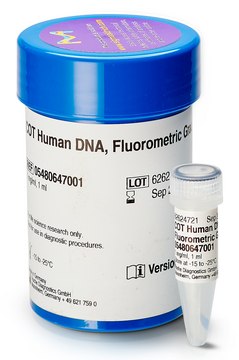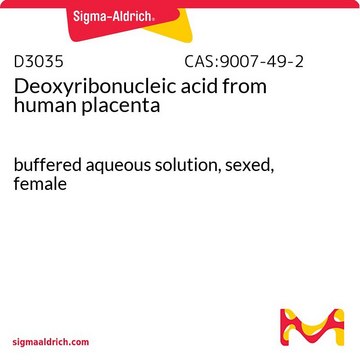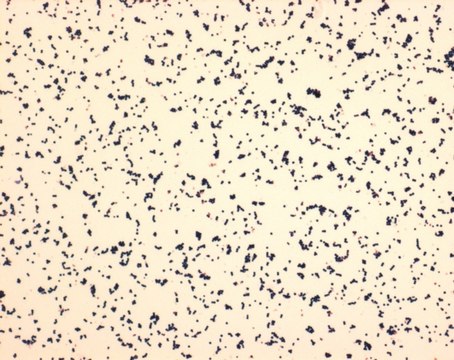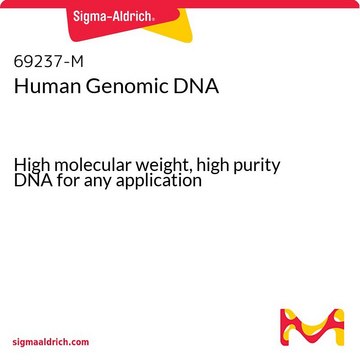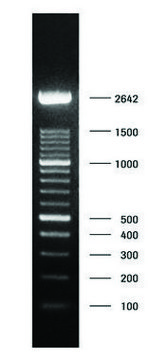11581074001
Roche
COT Human DNA
from human placenta DNA, enriched for repetitive sequences
Synonym(s):
COT Human DNA, Human DNA
Sign Into View Organizational & Contract Pricing
All Photos(1)
About This Item
UNSPSC Code:
41106310
Recommended Products
biological source
human placenta (DNA)
Quality Level
grade
Molecular Biology
form
solution
packaging
pkg of 500 μg
manufacturer/tradename
Roche
concentration
1 mg/mL
impurities
HCV/HBV, none detected
HIV 1/2, none detected
color
colorless
solubility
water: miscible
storage temp.
−20°C
Looking for similar products? Visit Product Comparison Guide
Related Categories
General description
Repetitive elements (IRS) present in a probe (e.g., cosmids, YACs, chromosome painting probes) generate nonspecific hybridization signals that are distributed over the whole chromosome or genome. To enable specific hybridization of the probe to the chromosomal target site (e.g., single-copy sequences or low-copy repeats) the probe must be denatured in the presence of excess unlabeled COT Human DNA. This DNA serves as a competitor. In a subsequent preannealing step, the repetitive probe elements rapidly hybridize to excess repeats in the COT Human DNA, while most of the specific probe sequences remain single-stranded and thus can be hybridized to their chromosomal targets. This technique is known as chromosomal in situ suppression (CISS) hybridization.
The COT fraction of human genomic DNA consists largely of rapidly annealing repetitive elements. These interspersed repetitive sequences (IRS) such as SINEs (small interspersed repetitive elements, e.g., Alu-elements) and LINEs (large interspersed repetitive elements, e.g., L1-elements) are distributed ubiquitously throughout the genome. COT Human DNA is prepared from human placental DNA by shearing, denaturing, and reannealing under conditions that enrich these repetitive elements.
Application
COT Human DNA is used in chromosome in situ suppression (CISS) hybridization. Cosmid or YAC probes contain repetitive elements that result in monospecific hybridization signals distributed over the entire chromosome. To enable specific hybridization to the chromosomal target site, the probe is denatured together with an excess of unlabeled COT Human DNA as a competitor. COT Human DNA can be used to suppress nonspecific hybridization to human repetitive sequences in microarray analysis, and in filter and in fluorescent in situ hybridization experiments.
Sequence
In agarose gel electrophoresis the length distribution of the COT Human DNA fragments shows a maximum in the range of 50 to 300 nucleotides.
Physical form
Solution, 1 mg/ml, 10 mM Tris-HCl, 1 mM EDTA, pH 7.4
Other Notes
For life science research only. Not for use in diagnostic procedures.
Storage Class Code
12 - Non Combustible Liquids
WGK
nwg
Flash Point(F)
No data available
Flash Point(C)
No data available
Regulatory Information
常规特殊物品
Choose from one of the most recent versions:
Already Own This Product?
Find documentation for the products that you have recently purchased in the Document Library.
Early S-phase cell hypersensitivity to heat stress
Nadezhda V
Cell Cycle (2016)
HiCTMap: Detection and Analysis of Chromosome Territory Structure and Position
by High-throughput Imaging
by High-throughput Imaging
Ziad Jowhar
Nature (2017)
Our team of scientists has experience in all areas of research including Life Science, Material Science, Chemical Synthesis, Chromatography, Analytical and many others.
Contact Technical Service
